tire size TOYOTA RAV4 HYBRID 2020 Warranties & Maintenance Guides (in English)
[x] Cancel search | Manufacturer: TOYOTA, Model Year: 2020, Model line: RAV4 HYBRID, Model: TOYOTA RAV4 HYBRID 2020Pages: 260, PDF Size: 8.54 MB
Page 51 of 260
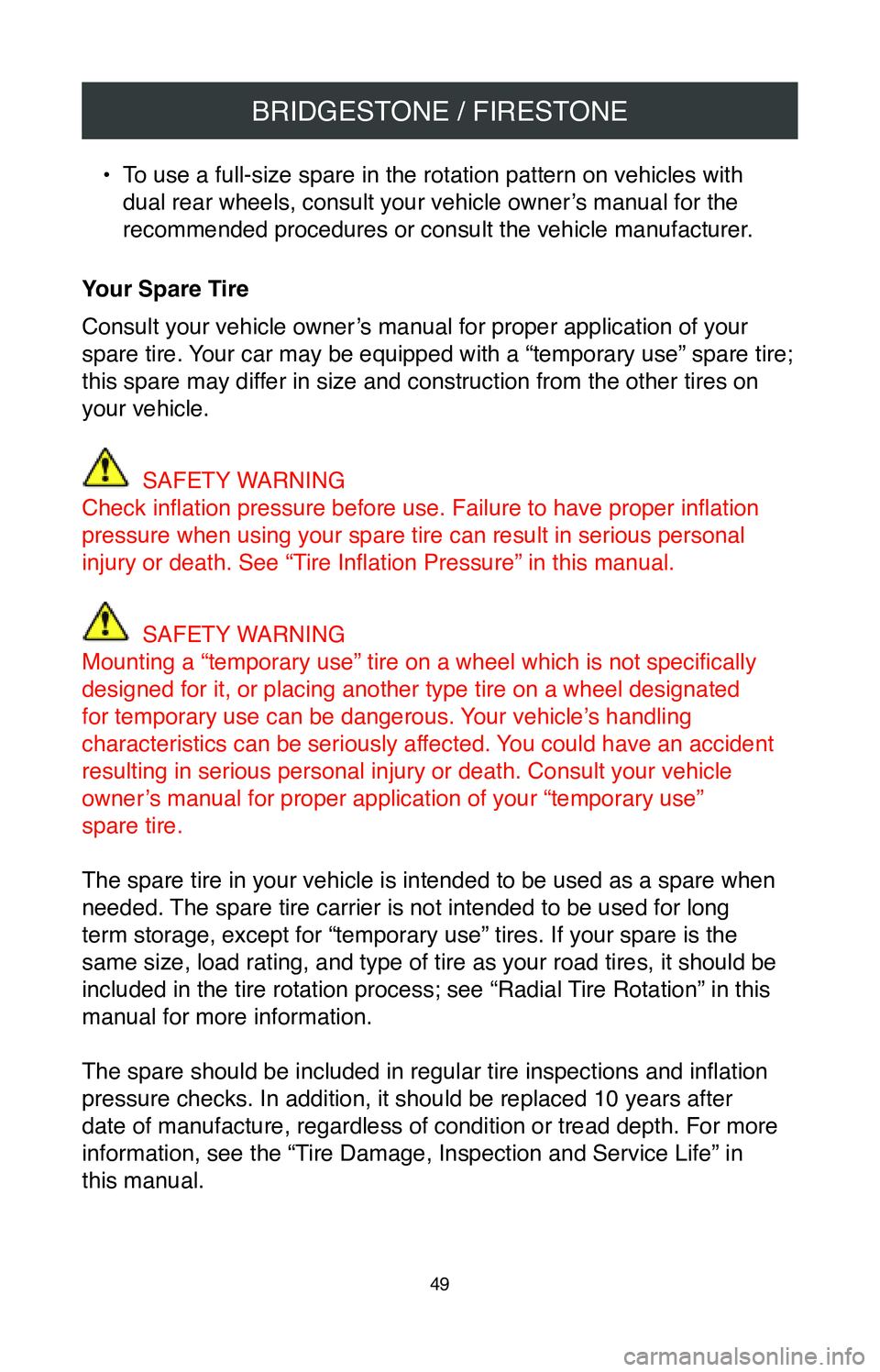
BRIDGESTONE / FIRESTONE
49
• To use a full-size spare in the rotation pattern on vehicles with
dual rear wheels, consult your vehicle owner’s manual for the
recommended procedures or consult the vehicle manufacturer.
Your Spare Tire
Consult your vehicle owner’s manual for proper application of your
spare tire. Your car may be equipped with a “temporary use” spare tire;
this spare may differ in size and construction from the other tires on
your vehicle.
SAFETY WARNING
Check inflation pressure before use. Failure to have proper inflation
pressure when using your spare tire can result in serious personal
injury or death. See “Tire Inflation Pressure” in this manual.
SAFETY WARNING
Mounting a “temporary use” tire on a wheel which is not specifically
designed for it, or placing another type tire on a wheel designated
for temporary use can be dangerous. Your vehicle’s handling
characteristics can be seriously affected. You could have an accident
resulting in serious personal injury or death. Consult your vehicle
owner’s manual for proper application of your “temporary use”
spare tire.
The spare tire in your vehicle is intended to be used as a spare when
needed. The spare tire carrier is not intended to be used for long
term storage, except for “temporary use” tires. If your spare is t\
he
same size, load rating, and type of tire as your road tires, it should b\
e
included in the tire rotation process; see “Radial Tire Rotation” in this
manual for more information.
The spare should be included in regular tire inspections and inflation
pressure checks. In addition, it should be replaced 10 years after
date of manufacture, regardless of condition or tread depth. For more
information, see the “Tire Damage, Inspection and Service Life” in
this manual.
Page 57 of 260
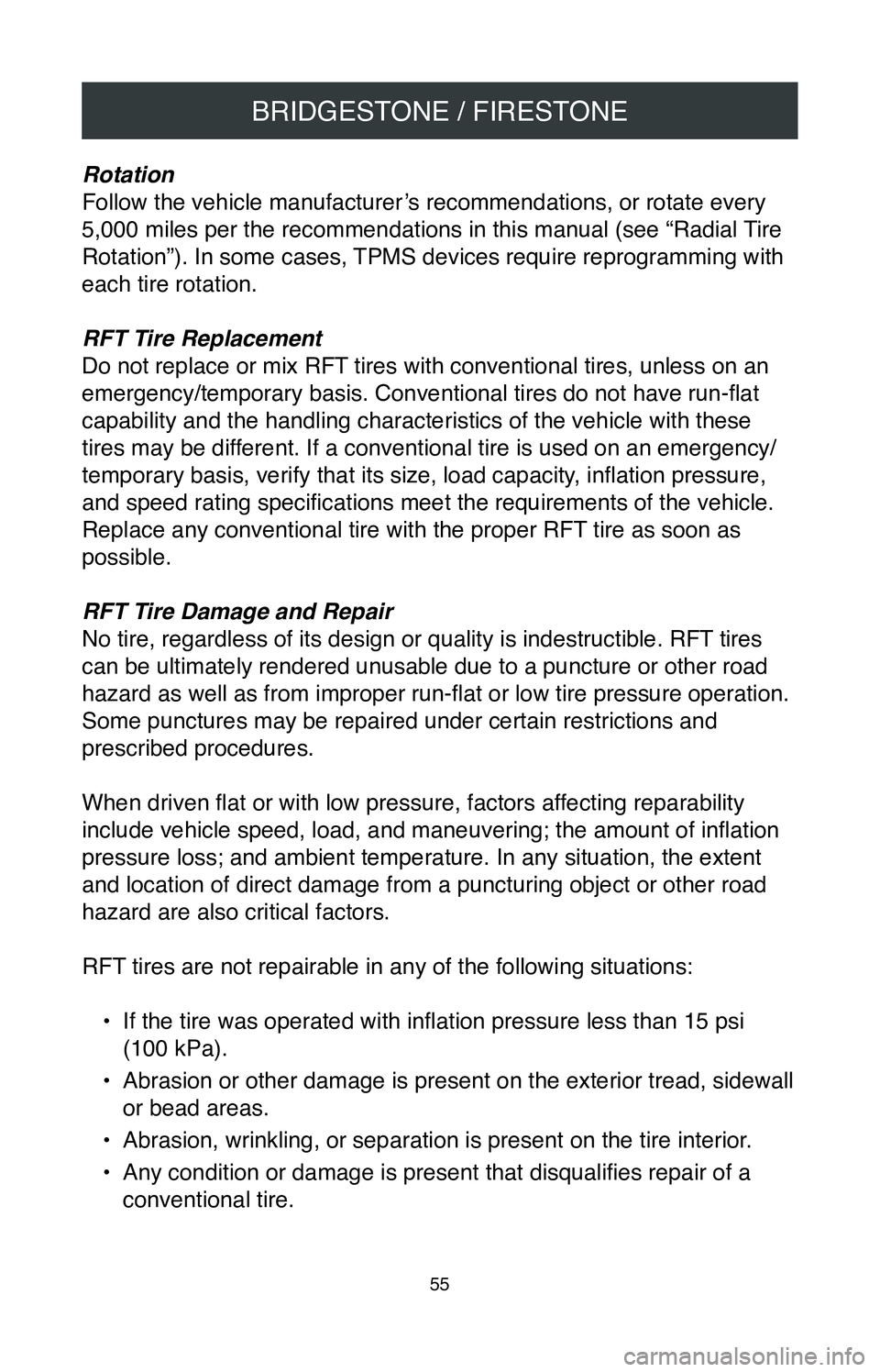
BRIDGESTONE / FIRESTONE
55
Rotation
Follow the vehicle manufacturer’s recommendations, or rotate every
5,000 miles per the recommendations in this manual (see “Radial Tire
Rotation”). In some cases, TPMS devices require reprogramming with
each tire rotation.
RFT Tire Replacement
Do not replace or mix RFT tires with conventional tires, unless on an
emergency/temporary basis. Conventional tires do not have run-flat
capability and the handling characteristics of the vehicle with these
tires may be different. If a conventional tire is used on an emergency/
temporary basis, verify that its size, load capacity, inflation pressure,
and speed rating specifications meet the requirements of the vehicle.
Replace any conventional tire with the proper RFT tire as soon as
possible.
RFT Tire Damage and Repair
No tire, regardless of its design or quality is indestructible. RFT tires
can be ultimately rendered unusable due to a puncture or other road
hazard as well as from improper run-flat or low tire pressure operation.
Some punctures may be repaired under certain restrictions and
prescribed procedures.
When driven flat or with low pressure, factors affecting reparability
include vehicle speed, load, and maneuvering; the amount of inflation
pressure loss; and ambient temperature. In any situation, the extent
and location of direct damage from a puncturing object or other road
hazard are also critical factors.
RFT tires are not repairable in any of the following situations:
•
If the tire was operated with inflation pressure less than 15 psi
(100 kPa).
•
Abrasion or other damage is present on the exterior tread, sidewall
or bead areas.
•
Abrasion, wrinkling, or separation is present on the tire interior.
•
Any condition or damage is present that disqualifies repair of a
conventional tire.
Page 59 of 260
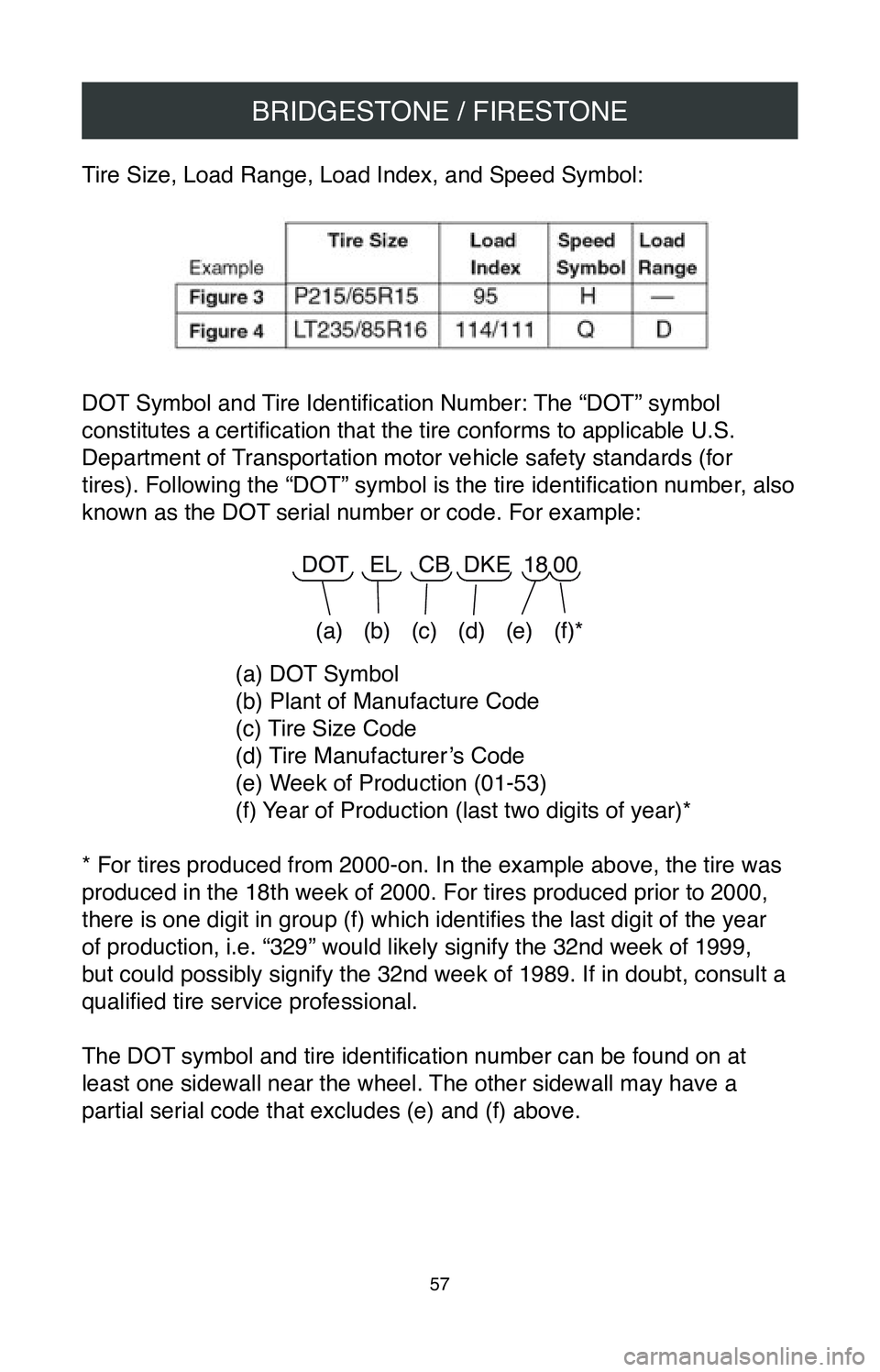
BRIDGESTONE / FIRESTONE
57
Tire Size, Load Range, Load Index, and Speed Symbol:
DOT Symbol and Tire Identification Number: The “DOT” symbol
constitutes a certification that the tire conforms to applicable U.S.
Department of Transportation motor vehicle safety standards (for
tires). Following the “DOT” symbol is the tire identification number, also
known as the DOT serial number or code. For example:
DOT EL CB DKE 18 00
(a) (b) (c) (d) (e) (f)*
(a) DOT Symbol
(b) Plant of Manufacture Code
(c) Tire Size Code
(d) Tire Manufacturer’s Code
(e) Week of Production (01-53)
(f) Year of Production (last two digits of year)*
* For tires produced from 2000-on. In the example above, the tire was
produced in the 18th week of 2000. For tires produced prior to 2000,
there is one digit in group (f) which identifies the last digit of the year
of production, i.e. “329” would likely signify the 32nd week of 19\
99,
but could possibly signify the 32nd week of 1989. If in doubt, consult a\
qualified tire service professional.
The DOT symbol and tire identification number can be found on at
least one sidewall near the wheel. The other sidewall may have a
partial serial code that excludes (e) and (f) above.
Page 60 of 260
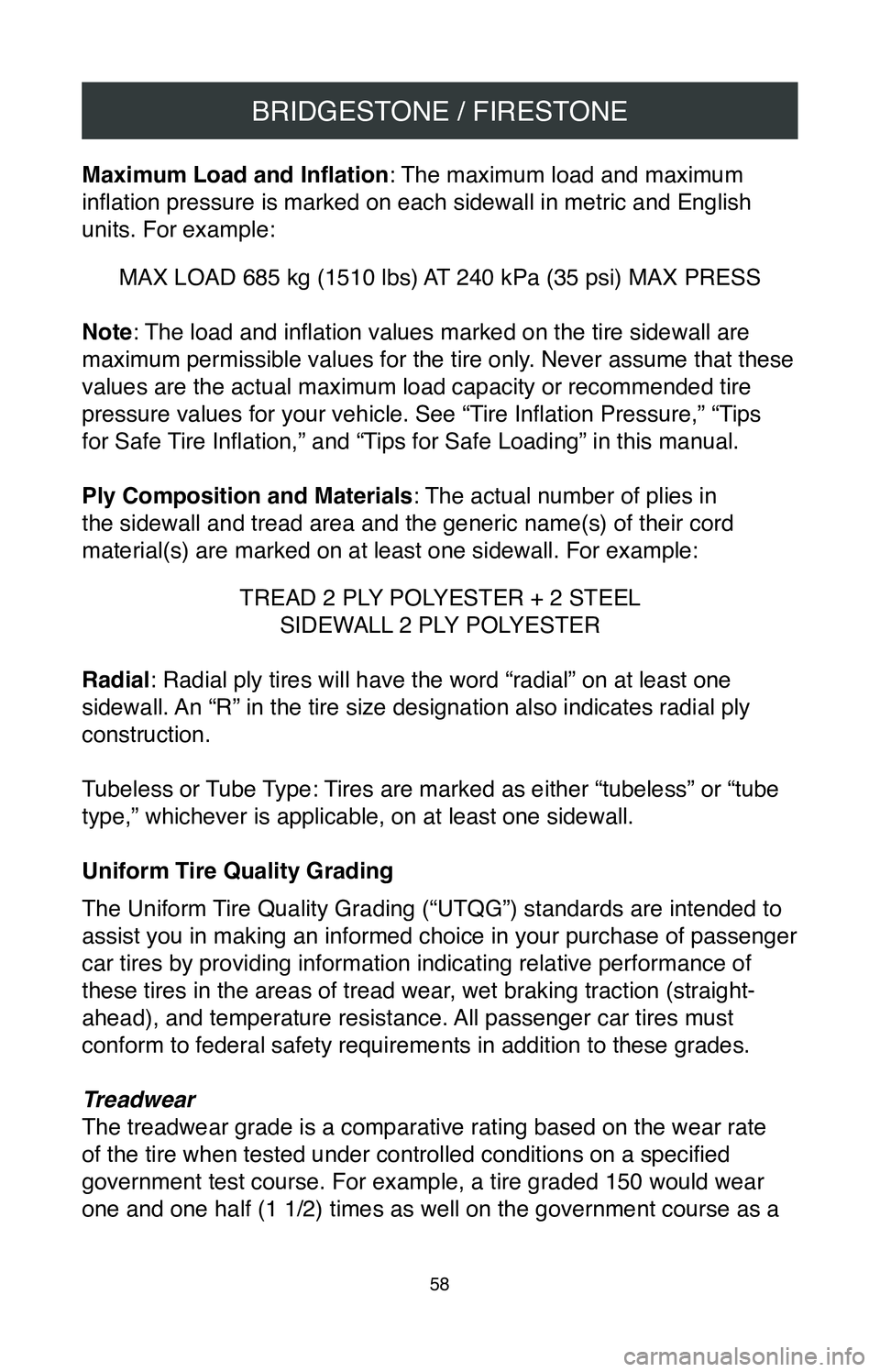
BRIDGESTONE / FIRESTONE
58
Maximum Load and Inflation: The maximum load and maximum
inflation pressure is marked on each sidewall in metric and English
units. For example:
MAX LOAD 685 kg (1510 lbs) AT 240 kPa (35 psi) MAX PRESS
Note: The load and inflation values marked on the tire sidewall are
maximum permissible values for the tire only. Never assume that these
values are the actual maximum load capacity or recommended tire
pressure values for your vehicle. See “Tire Inflation Pressure,” “Tips
for Safe Tire Inflation,” and “Tips for Safe Loading” in this manual.
Ply Composition and Materials : The actual number of plies in
the sidewall and tread area and the generic name(s) of their cord
material(s) are marked on at least one sidewall. For example:
TREAD 2 PLY POLYESTER + 2 STEEL SIDEWALL 2 PLY POLYESTER
Radial: Radial ply tires will have the word “radial” on at least one
sidewall. An “R” in the tire size designation also indicates radial ply
construction.
Tubeless or Tube Type: Tires are marked as either “tubeless” or “tube
type,” whichever is applicable, on at least one sidewall.
Uniform Tire Quality Grading
The Uniform Tire Quality Grading (“UTQG”) standards are intended to
assist you in making an informed choice in your purchase of passenger
car tires by providing information indicating relative performance of
these tires in the areas of tread wear, wet braking traction (straight-
ahead), and temperature resistance. All passenger car tires must
conform to federal safety requirements in addition to these grades.
Treadwear
The treadwear grade is a comparative rating based on the wear rate
of the tire when tested under controlled conditions on a specified
government test course. For example, a tire graded 150 would wear
one and one half (1 1/2) times as well on the government course as a
Page 76 of 260
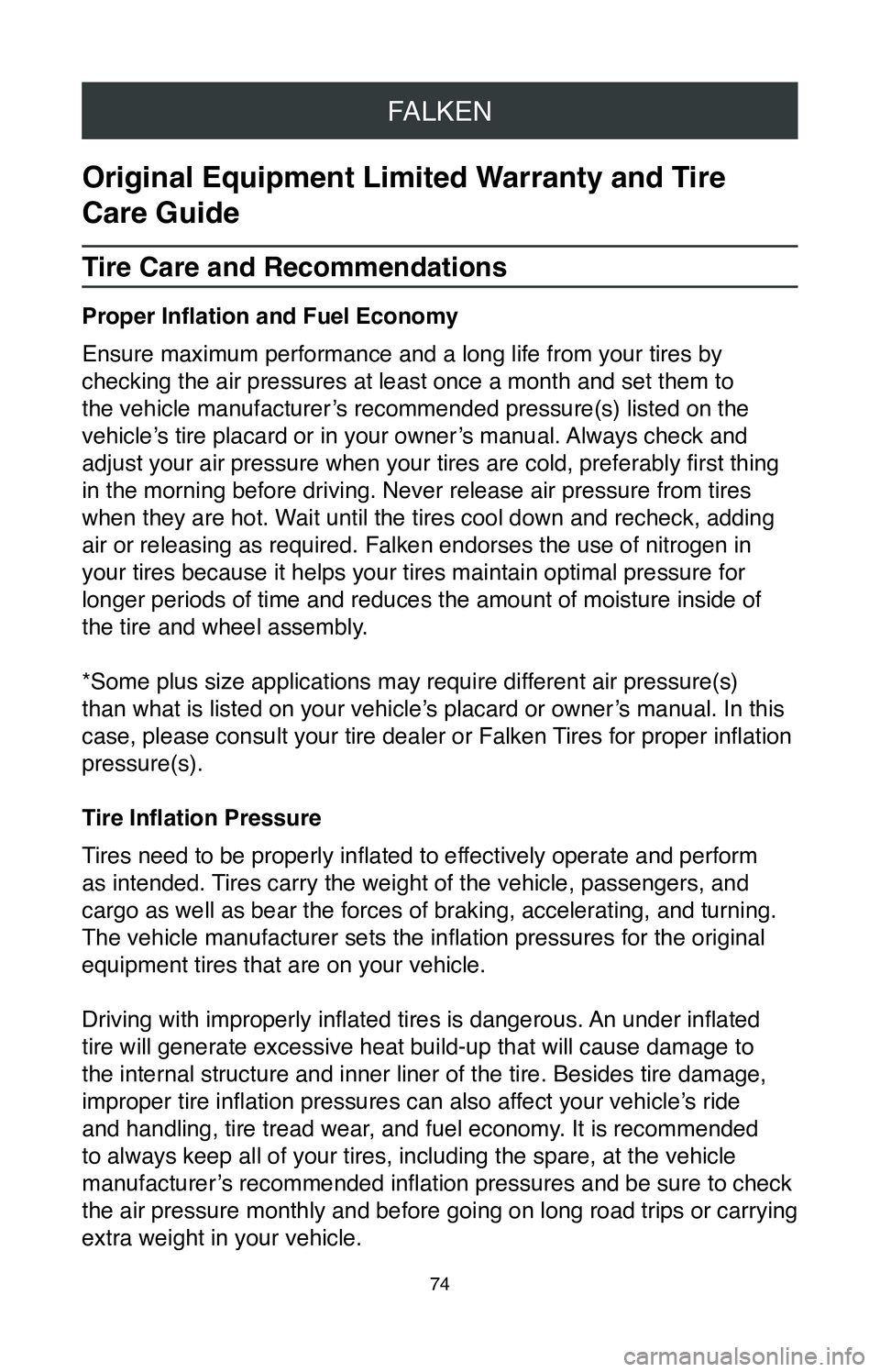
FALKEN
74
Original Equipment Limited Warranty and Tire
Care Guide
Tire Care and Recommendations
Proper Inflation and Fuel Economy
Ensure maximum performance and a long life from your tires by
checking the air pressures at least once a month and set them to
the vehicle manufacturer’s recommended pressure(s) listed on the
vehicle’s tire placard or in your owner’s manual. Always check and
adjust your air pressure when your tires are cold, preferably first thing
in the morning before driving. Never release air pressure from tires
when they are hot. Wait until the tires cool down and recheck, adding
air or releasing as required. Falken endorses the use of nitrogen in
your tires because it helps your tires maintain optimal pressure for
longer periods of time and reduces the amount of moisture inside of
the tire and wheel assembly.
*Some plus size applications may require different air pressure(s)
than what is listed on your vehicle’s placard or owner’s manual. In this
case, please consult your tire dealer or Falken Tires for proper inflation
pressure(s).
Tire Inflation Pressure
Tires need to be properly inflated to effectively operate and perform
as intended. Tires carry the weight of the vehicle, passengers, and
cargo as well as bear the forces of braking, accelerating, and turning. \
The vehicle manufacturer sets the inflation pressures for the original
equipment tires that are on your vehicle.
Driving with improperly inflated tires is dangerous. An under inflated
tire will generate excessive heat build-up that will cause damage to
the internal structure and inner liner of the tire. Besides tire damage,\
improper tire inflation pressures can also affect your vehicle’s ride
and handling, tire tread wear, and fuel economy. It is recommended
to always keep all of your tires, including the spare, at the vehicle
manufacturer’s recommended inflation pressures and be sure to check
the air pressure monthly and before going on long road trips or carrying
extra weight in your vehicle.
Page 80 of 260
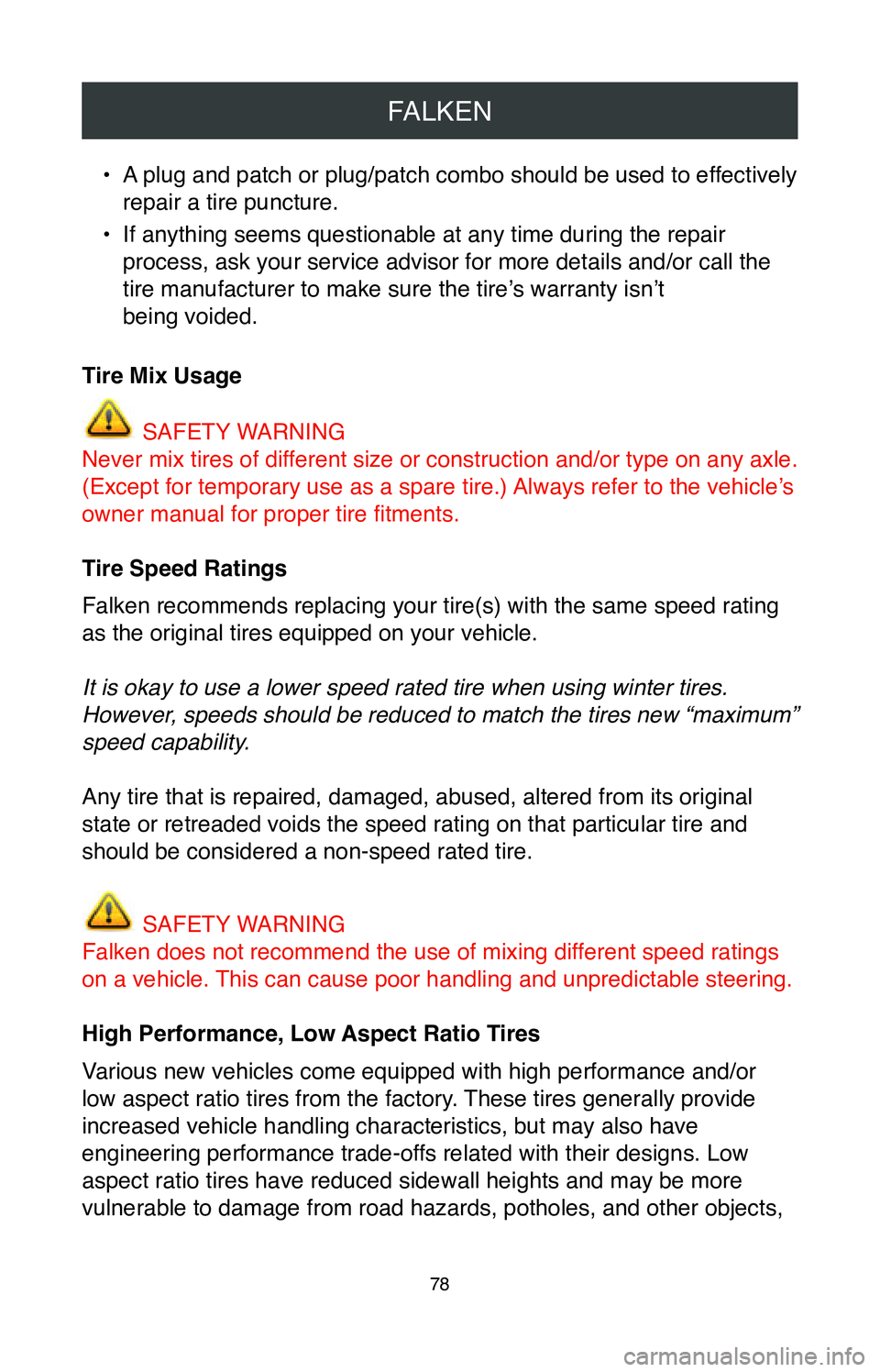
FALKEN
78
• A plug and patch or plug/patch combo should be used to effectively
repair a tire puncture.
•
If anything seems questionable at any time during the repair
process, ask your service advisor for more details and/or call the
tire manufacturer to make sure the tire’s warranty isn’t
being voided.
Tire Mix Usage
SAFETY WARNING
Never mix tires of different size or construction and/or type on any axle.
(Except for temporary use as a spare tire.) Always refer to the vehicle’s
owner manual for proper tire fitments.
Tire Speed Ratings
Falken recommends replacing your tire(s) with the same speed rating
as the original tires equipped on your vehicle.
It is okay to use a lower speed rated tire when using winter tires.
However, speeds should be reduced to match the tires new “maximum”
speed capability.
Any tire that is repaired, damaged, abused, altered from its original
state or retreaded voids the speed rating on that particular tire and
should be considered a non-speed rated tire.
SAFETY WARNING
Falken does not recommend the use of mixing different speed ratings
on a vehicle. This can cause poor handling and unpredictable steering.
High Performance, Low Aspect Ratio Tires
Various new vehicles come equipped with high performance and/or
low aspect ratio tires from the factory. These tires generally provide
increased vehicle handling characteristics, but may also have
engineering performance trade-offs related with their designs. Low
aspect ratio tires have reduced sidewall heights and may be more
vulnerable to damage from road hazards, potholes, and other objects,
Page 85 of 260
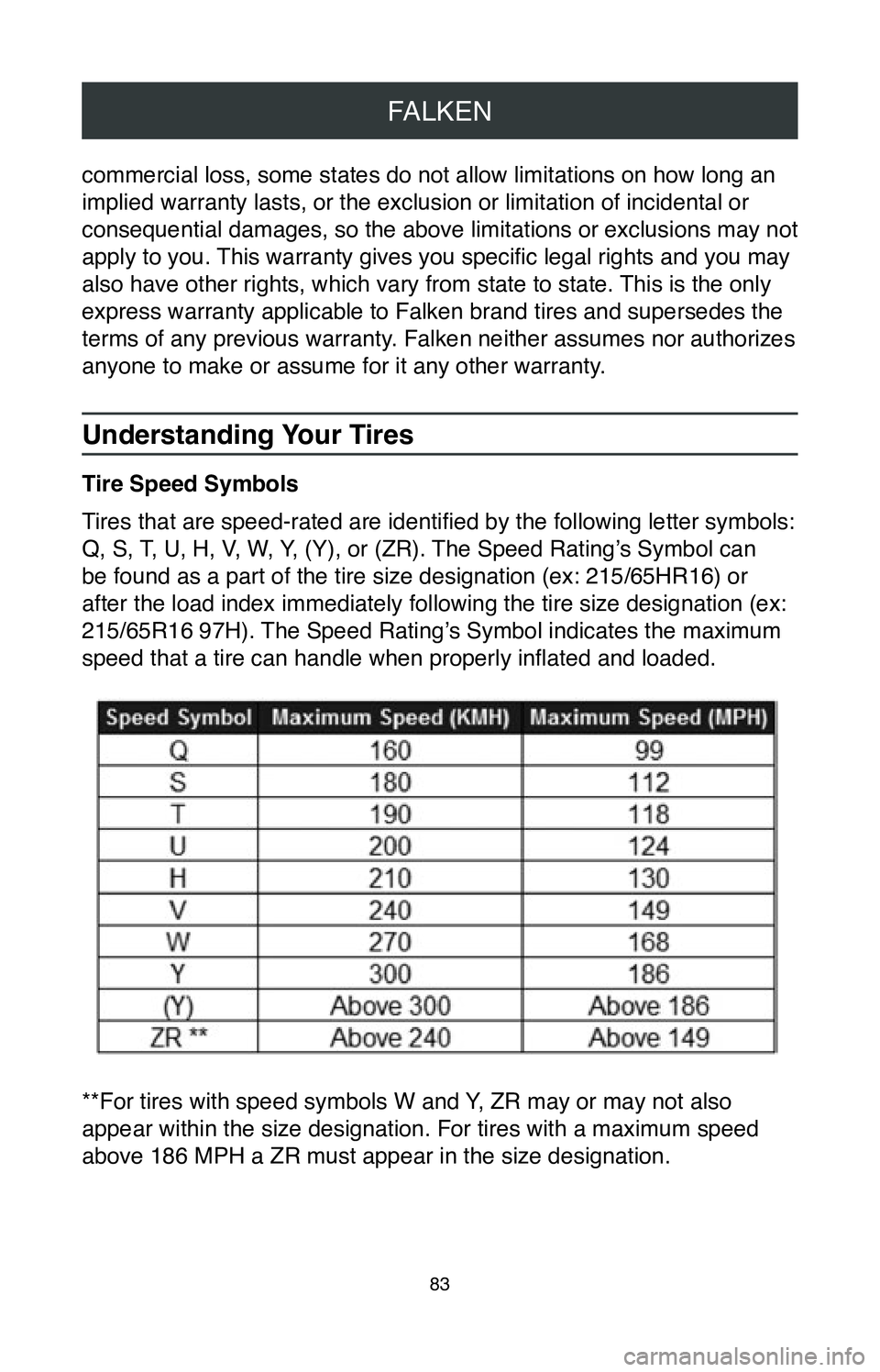
FALKEN
83
commercial loss, some states do not allow limitations on how long an
implied warranty lasts, or the exclusion or limitation of incidental or \
consequential damages, so the above limitations or exclusions may not
apply to you. This warranty gives you specific legal rights and you may
also have other rights, which vary from state to state. This is the only
express warranty applicable to Falken brand tires and supersedes the
terms of any previous warranty. Falken neither assumes nor authorizes
anyone to make or assume for it any other warranty.
Understanding Your Tires
Tire Speed Symbols
Tires that are speed-rated are identified by the following letter symbols:
Q, S, T, U, H, V, W, Y, (Y), or (ZR). The Speed Rating’s Symbol can
be found as a part of the tire size designation (ex: 215/65HR16) or
after the load index immediately following the tire size designation (ex:
215/65R16 97H). The Speed Rating’s Symbol indicates the maximum
speed that a tire can handle when properly inflated and loaded.
**For tires with speed symbols W and Y, ZR may or may not also
appear within the size designation. For tires with a maximum speed
above 186 MPH a ZR must appear in the size designation.
Page 86 of 260
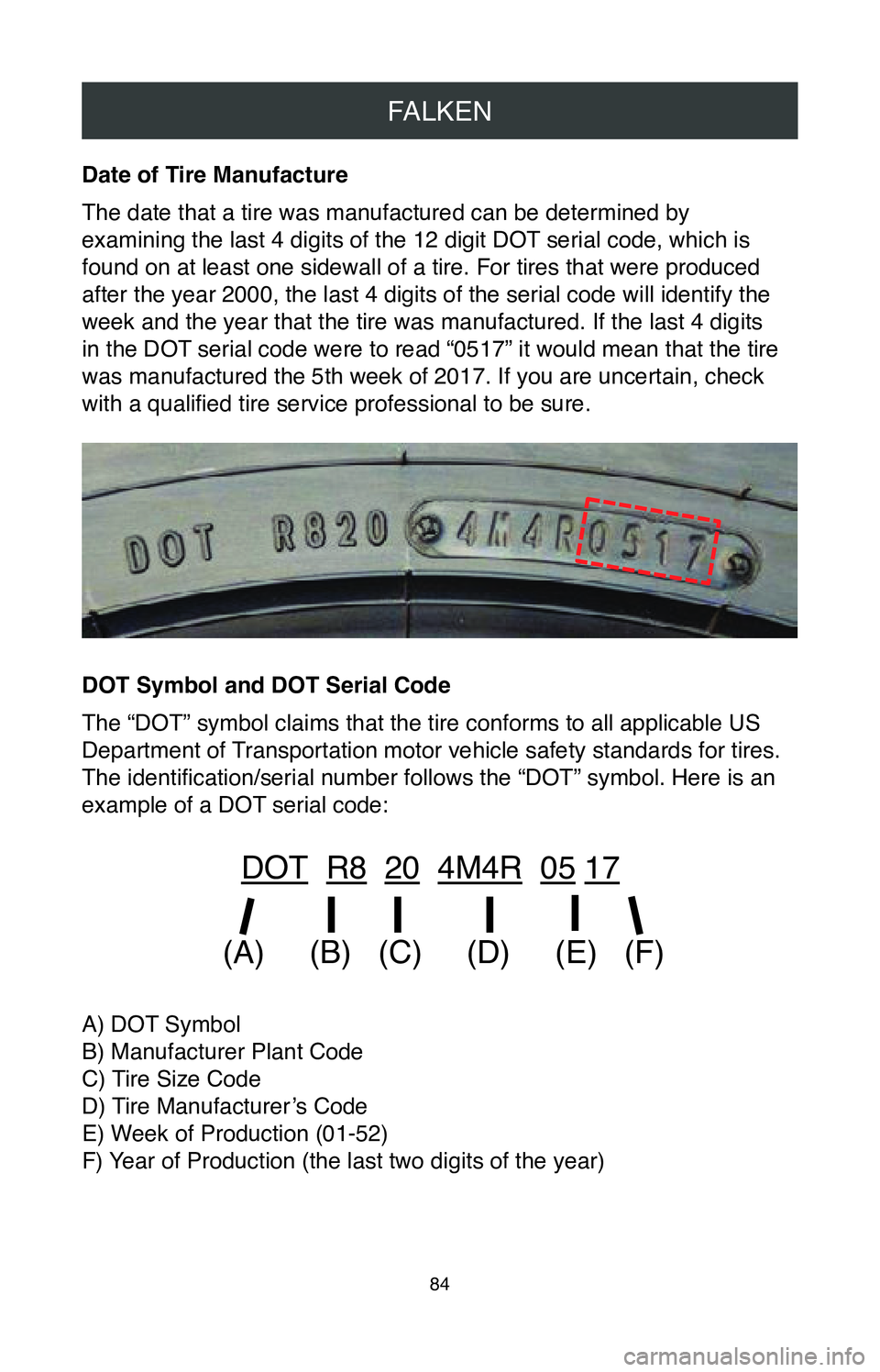
FALKEN
84
Date of Tire Manufacture
The date that a tire was manufactured can be determined by
examining the last 4 digits of the 12 digit DOT serial code, which is
found on at least one sidewall of a tire. For tires that were produced
after the year 2000, the last 4 digits of the serial code will identify the
week and the year that the tire was manufactured. If the last 4 digits
in the DOT serial code were to read “0517” it would mean that the tire
was manufactured the 5th week of 2017. If you are uncertain, check
with a qualified tire service professional to be sure.
DOT Symbol and DOT Serial Code
The “DOT” symbol claims that the tire conforms to all applicable US
Department of Transportation motor vehicle safety standards for tires.
The identification/serial number follows the “DOT” symbol. Here is an
example of a DOT serial code:
DOT R8 20 4M4R 05 17
(A) (B) (C) (D) (E) (F)
A) DOT Symbol
B) Manufacturer Plant Code
C) Tire Size Code
D) Tire Manufacturer’s Code
E) Week of Production (01-52)
F) Year of Production (the last two digits of the year)
Page 87 of 260
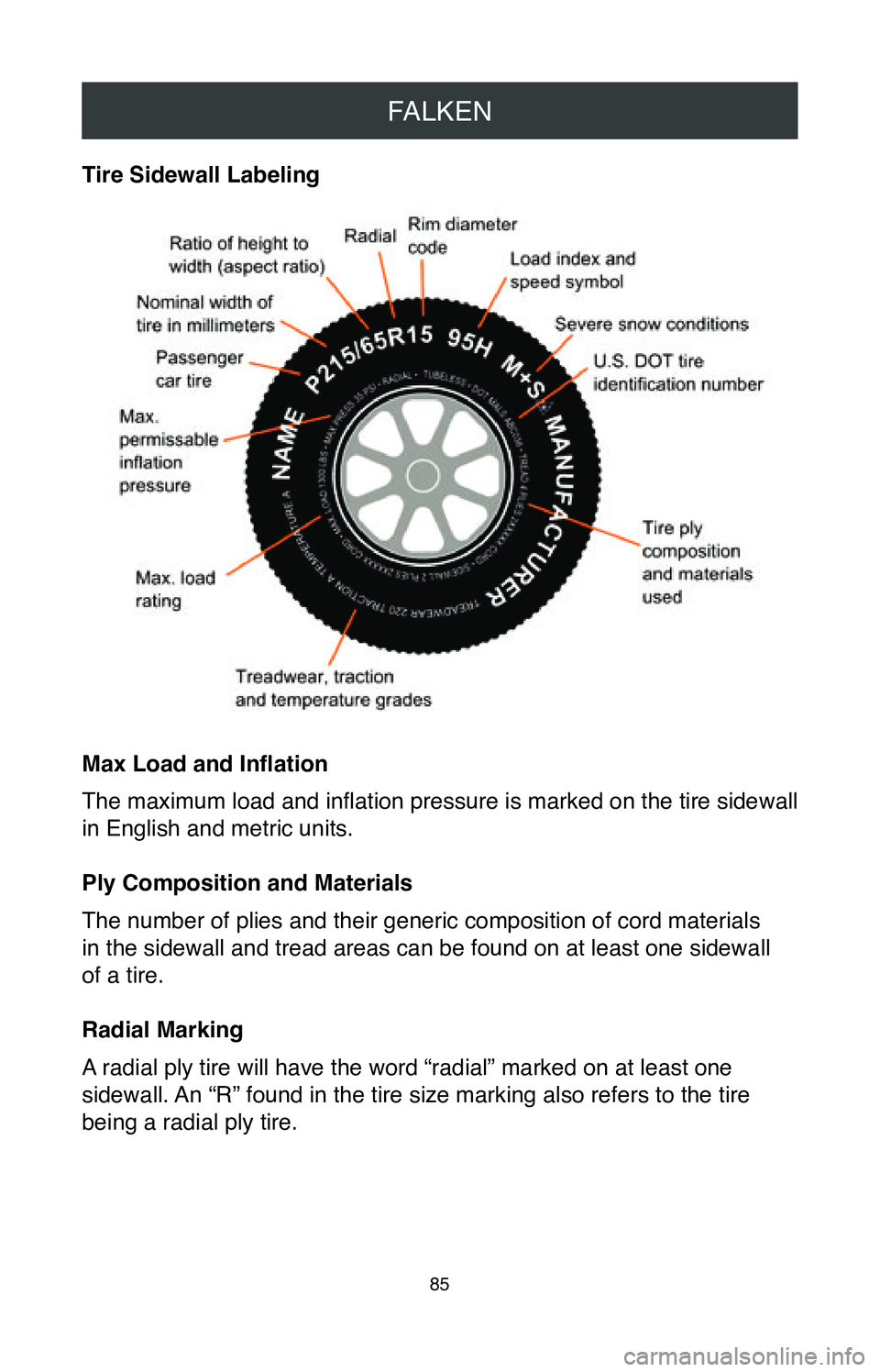
FALKEN
85
Tire Sidewall Labeling
Max Load and Inflation
The maximum load and inflation pressure is marked on the tire sidewall
in English and metric units.
Ply Composition and Materials
The number of plies and their generic composition of cord materials
in the sidewall and tread areas can be found on at least one sidewall
of a tire.
Radial Marking
A radial ply tire will have the word “radial” marked on at least on\
e
sidewall. An “R” found in the tire size marking also refers to the tire
being a radial ply tire.
Page 93 of 260
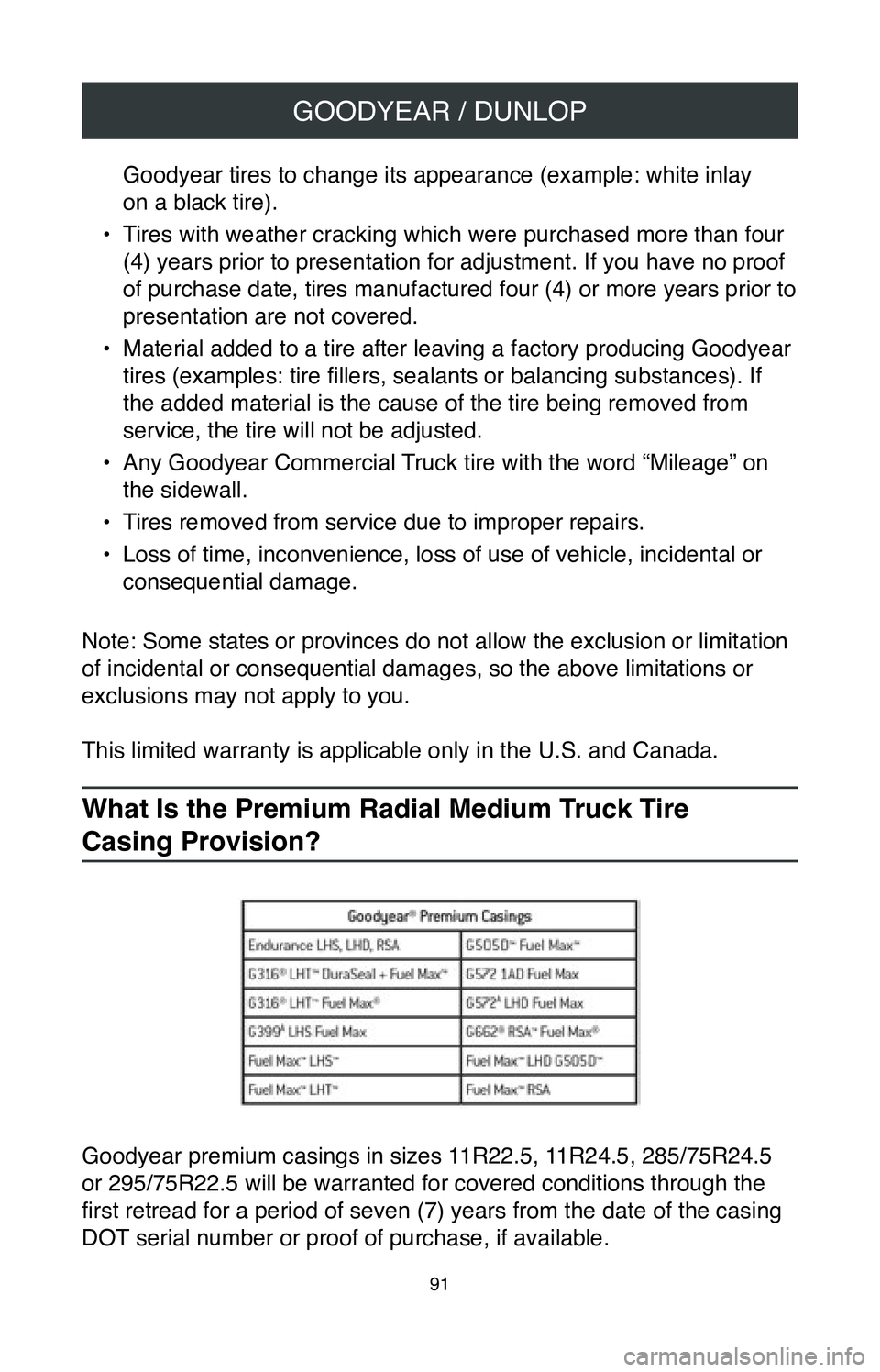
GOODYEAR / DUNLOP
91
Goodyear tires to change its appearance (example: white inlay
on a black tire).
•
Tires with weather cracking which were purchased more than four
(4) years prior to presentation for adjustment. If you have no proof
of purchase date, tires manufactured four (4) or more years prior to
presentation are not covered.
•
Material added to a tire after leaving a factory producing Goodyear
tires (examples: tire fillers, sealants or balancing substances). If
the added material is the cause of the tire being removed from
service, the tire will not be adjusted.
•
Any Goodyear Commercial Truck tire with the word “Mileage” on
the sidewall.
•
Tires removed from service due to improper repairs.
•
Loss of time, inconvenience, loss of use of vehicle, incidental or
consequential damage.
Note: Some states or provinces do not allow the exclusion or limitation \
of incidental or consequential damages, so the above limitations or
exclusions may not apply to you.
This limited warranty is applicable only in the U.S. and Canada.
What Is the Premium Radial Medium Truck Tire
Casing Provision?
Goodyear premium casings in sizes 11R22.5, 11R24.5, 285/75R24.5
or 295/75R22.5 will be warranted for covered conditions through the
first retread for a period of seven (7) years from the date of the casing
DOT serial number or proof of purchase, if available.